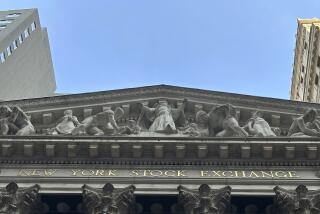Once-Thriving Biotech Stocks Suffer Setbacks
- Share via
SAN DIEGO — Wall Street’s new skittish attitude toward biotechnology stocks hit hard earlier this month at San Diego’s Viagene biotech company.
The company, which is developing a therapeutic drug for HIV-positive patients, filed for an initial public offering to raise money for very expensive clinical trials. But later that day, April 15, Viagene’s plans were put on hold.
Malvern, Pa.-based Centocor announced that the Food and Drug Administration had declined to approve its Centoxin septic shock treatment drug--a decision that led to the resignation Tuesday of Centocor President James E. Wavle Jr.
Biotech stocks--a hot group last year--immediately tumbled in a fall that has yet to stop. With potential sales of $1 billion or more, Centoxin was to have been the first bioengineered mega-product since Amgen’s erythropoietin (EPO) was approved by the FDA in 1989.
Viagene won’t offer the planned issue of 2.25 million shares until “the market stabilizes and becomes more receptive to biotechnology issues,” said its chief executive, Robert T. Abbot.
“It’s an inconvenience,” he said, adding that the company has enough funds to get through this year and early 1993 and that it can tap institutional investors if need be. “But I’ve been in the industry for eight years and I’ve learned that one simply rolls with the punches.”
The biotechnology industry has received several punches since January, a flurry that has caused biotechnology stocks to lose more than half their value this year, according a stock index compiled by Smith Barney, Harris Upham & Co. in San Francisco. “There has been a steady string of disappointments,” said Denise Gilbert, Smith Barney’s biotechnology analyst.
While biotechnology stocks always have been volatile, rising and falling on the success or failure of highly touted wonder drugs such as EPO and Centoxin, observers expect the current malaise in biotechnology stock prices to linger for at least several months, in part because FDA product-approval standards are getting tougher.
The stock drop may also have shut the longest-running “window” in biotechnology stock offerings since the industry was born in the late 1970s. Over the last 16 months, 55 biotechnology companies have held initial public stock offerings, raising an estimated $1.75 billion, according to BioWorld Today, a San Mateo-based daily newspaper that covers the bioscience industry.
The first major blow to the biotech industry occurred in late January, when the FDA failed to recommend the approval of Ethyol, a drug developed by U.S. Bioscience of Conshokocken, Pa. The product, aimed at reducing the toxicity of anti-cancer treatments, had completed advanced clinical trials late last year and seemed a good bet to reach the market this year.
Then in early February, MGI Pharma of Minneapolis pulled its MGI 136 product, an anti-toxicity product for chemotherapy patients similar to U.S. Bioscience’s, from clinical trials after a board of independent reviewers raised questions about the product’s safety. Earlier this month, MGI Pharma “made the suspension of clinical trials permanent,” a spokeswoman said.
But the worst news was that the FDA delay of Centoxin’s approval might force the company to re-enter the drug in clinical trials. The company is still negotiating with the FDA on what specific additional clinical data will be required.
If approved, Centoxin might have been administered to between 400,000 and 500,000 surgical patients a year “at a cost of between $2,000 and $4,000 a pop,” Gilbert said.
Centoxin’s market potential was so great that an FDA approval would have lifted the entire industry, observers said. But the setback, plus the decline in drug stocks in general in 1992, are “dragging down every other biotech stock,” said Howard (Ted) Greene, chief executive of Amylin, a San Diego biotechnology company that is developing treatments for diabetes and obesity. Amylin raised $56 million in an initial stock offering in January.
The surprise FDA announcement caused investors to reduce expectations that other drugs would be approved, Greene said. “And if you discount the likelihood of FDA approval, you are discounting the value of their stock, because only a fraction of biotechnology stocks are based on actual sales and earnings.”
The FDA refusal hit Centocor particularly hard because the company had increased its overhead to hire 200 direct-sales people to sell a drug that is unavailable.
Executives at Centocor said Tuesday the firm is considering the sale of an equity stake to another firm in an effort to raise capital.
In fact, the industry could be ripe for consolidations similar to several deals in recent years, because some strong biotechnology companies, such as Amgen, have lots of cash.
Several observers, including Gilbert and Greene, believe that the FDA’s Centoxin decision signals a tougher stance toward biotech drugs and that the controversy surrounding breast implants and heart valves has hardened regulators to arguments that the unique benefits of some bioengineered drugs could outweigh the risks.
And it is unlikely that biotechnology stocks are headed for a quick turnaround, mainly because there are no blockbuster drugs with the potential of a Centoxin or an EPO now before the FDA for approval, Gilbert said.
A Biotech Roller Coaster Although the S&P; index trended steadily upward over the past two years, the biotechnology stock chart compiled by Smith Barney Upham Harris shows a wild roller coaster ride of highs and lows, a sign of the volatility of a stock group that is highly subject to the successes and failures of single “blockbuster” drugs. Source: Smith Barney, Harris Upham & Co.
More to Read
Inside the business of entertainment
The Wide Shot brings you news, analysis and insights on everything from streaming wars to production — and what it all means for the future.
You may occasionally receive promotional content from the Los Angeles Times.










